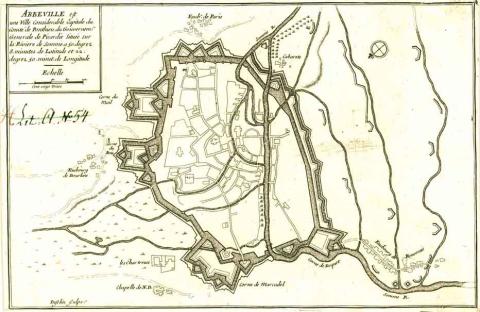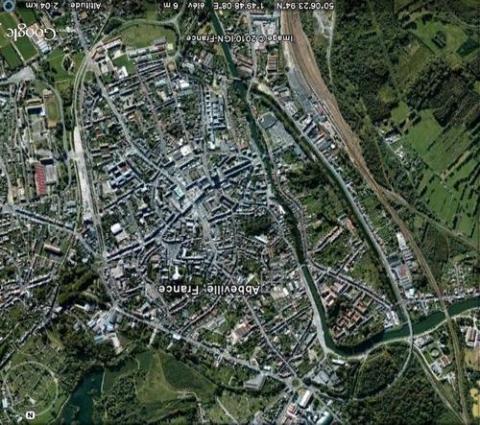Abbeville
History and description
Manifest for the first time in 831, in what was then Abbatis-Villa, in a chronicle of the abbaye de Saint-Ricquier, Abbeville was bequeathed in 987 by Hughes Capet to his stepson, Hughes count of Montreuil. The latter count was the first in the line of counts of Ponthieu and constructed the first urban wall around the town in 990. This first urban wall included walls, moats and a count’s castle near the porte de Saint-Gilles. Part of the protection was provided by the Somme. This first wall was replaced between 1185 and 1200 by another constructed by the franchised local authorities in 1184. It included the suburbs of Saint-Gilles, de Bois, Saint-Jacques, Saint-Jean-des-Prés and Bourg du Vimieu. Rapidly proving inadequate, it was, in turn, replaced by the third wall, the perimeter of which was expanded still further, between 1200 and 1210. This third urban wall included round towers and crenellated walls, as well as four gates: porte de Saint-Gilles, porte du Bois, porte de Saint-Jean-des-Prés and porte Bourg de Vimieu. The count’s castle was replaced by a new construction in 1279, built on the orders of Edward I of England. Three years later, a modification of the route of the urban wall saw the château Neuf contained within the urban ramparts. Between 1280 and 1477, the ruler of Abbeville changed more than once during the Hundred Years war and during the wars between Louis XI of France and the Duke of Burgundy Charles the Bold. It was during the 15th century, during these wars, that the Pontoise fortifications were adapted for the first time to artillery by the reinforcement of the walls. In 1471, Charles the Bold constructed a second castle, unlike the first, from which to survey the town. This second castle was later obliterated in 1591 during the religious wars. In 1505, the first castle was transformed into a prison. Under Louis XI, a fourth urban wall was built with the sealing of the rift between the porte de Saint-Gilles and the porte de Saint-Jean-des-Prés, for which the swampy land had served as a means of defence up to that point. On the Somme itself, the defence was ensured by the portcullises under the bridges and the channels extending across the river.Francis I continued the programme of reinforcement of the urban wall started by Louis XI but it was his son, Henri II, who would oversee the construction of the first modern works. The bastion de Longueville, also known as the Quatre Coins (‘Four Corners’), was constructed under his reign between 1551 and 1559. The Retz Field Marshal added a ravelin and the mail curtain in 1585, at the initiative of Charles IX. Between 1596 and 1600, Henri IV had avenues built from the porte de Saint-Gilles, the porte de Macardé and the porte de Bois. Progress on the porte de Macardé continued and it was given a modern renewal while the other fortifications were reconsolidated. Two bastions were constructed under his reign (Saint-Paul and Rambures), while that of Longuetown was modified. However, these projects remained incomplete at the time of his passing in 1610. The cardinal of Richelieu, the Prime Minister under Louis XIII, visited the site on 29 October 1636 and ordered the construction of counterscarps, glacis and a ravelin between the porte de Saint-Gilles and the porte de Bois. This period also saw the works of Henri IV come to an end and the construction of two additional bastions (those of the Castle and Macardé). Another ravelin was also built in front of the Porte de Bois (in Noyers) and a hornwork, dubbed Champ de Mars, to complete the northern defences. However, the progressive backsliding of the frontier with Holland which went from 1635 up to 1697 saw Abbeville demoted, from the first to the third, even the fourth line of defence nullified. This situation saw the site become something of a ghost town.
In a report dated 1688, Vauban informed us that the fortifications of Abbeville were in ruins and that the town no longer had any defensive lock. To improve the defences, he added a crown work including two ravelins and a central structure to the north, built tunnels throughout up to the surrounding wall, had elms planted to stabilise the embankments between the porte de Saint-Gilles and the porte de Bois and installed a system of water defences. For the remainder, he fixed the areas in decline and championed the installation of a significant contingent of cavalry to reinforce the garrison. This latter suggestion was based on the large number of foraging prairies in the region, a ready food source for the horses.
The eighteenth century did not bring with it any further modification to the Abbeville fortifications. The only new constructions were a coastguard installed on rue des Capucins and a large barracks with stables near the porte de Saint-Gilles (constructed in 1780). A French Military Engineering report from the First Republic dating back to 1793 cites the ruined fortifications and the need for public contributions and a conscription drive to see them restored. This restoration took place between 1794 and 1812, during which time the counterguard of the bastion de Rambure was built. From 1812 to 1814, the porte de Rambure was modernised. Under the Restoration, the medieval rampart between the porte de Macardé and the river Scardon, a tributary of the Somme, was replaced by an earthen rampart. In 1831-34, the July Monarchy constructed a grassy bastion near the medieval tour des Hauts-Prés. Napoléon III downgraded Abbeville in 1867, which was followed by the initial demolitions in 1869. The Franco-Prussian war from 1870-1871 and the fall of the Second Empire interrupted these demolitions and led to those still living there rearming themselves ; constructing fencing in front of the suburbs up to 28 January, 1871 and the French capitulation. The Prussians demolished immediately these provisional defences. In 1872, the Third Republic downgraded Abbeville for the final time, which saw it demolished in multiple phases, with the project finally completed in 1906.
Current state
Little remains of the Abbeville ramparts: the barracks and the coastguard of 1780 (classed as historical monuments and restored in 1995), the remainders of the bastion de Longueville and a medieval tower. Circuits for visitors are the best way to retrace steps, with more information available at the local tourist office.
Abbeville
Abbeville
50° 6' 10.4854" N, 1° 49' 48.0295" E
Type
urban wall
Department
Somme
Region
Hauts-de-France
Bibliography
- BRAGARD (P.), CHEUVA (P.), COMBEAU (Y.) et al., Etoiles de pierre. Voyage en Nord Pas-de-Calais, Villeneuve-d’Ascq, 2003.
- DEVISNES (G), Histoire d’Abbeville et de sa région, des origines à l’aube du XXIe siècle, Paris, 2004.
- LOUANDRE (F.-C.), Histoire ancienne et moderne d’Abbeville et de son arrondissement, Abbeville, 1834.

